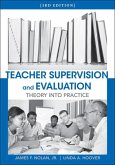- Gebundenes Buch
- Merkliste
- Auf die Merkliste
- Bewerten Bewerten
- Teilen
- Produkt teilen
- Produkterinnerung
- Produkterinnerung
* Continues a unique "Through The New Teacher′s Eyes" feature covering each chapter′s main topic from the perspective of three new teachers from diverse backgrounds and teaching in different (elementary, middle, and high school) environments.
Andere Kunden interessierten sich auch für
![Managing Today's University Managing Today's University]() Frederick E BalderstonManaging Today's University66,99 €
Frederick E BalderstonManaging Today's University66,99 €![Teacher Supervision and Evaluation Teacher Supervision and Evaluation]() James NolanTeacher Supervision and Evaluation229,99 €
James NolanTeacher Supervision and Evaluation229,99 €![Improving Schools from Within Improving Schools from Within]() Roland S BarthImproving Schools from Within19,99 €
Roland S BarthImproving Schools from Within19,99 €![The Accelerated Schools Resource Guide The Accelerated Schools Resource Guide]() Wendy S HopfenbergThe Accelerated Schools Resource Guide63,99 €
Wendy S HopfenbergThe Accelerated Schools Resource Guide63,99 €![Redesigning Schools Redesigning Schools]() Joseph P McdonaldRedesigning Schools50,99 €
Joseph P McdonaldRedesigning Schools50,99 €![Financing Schools for High Performance Financing Schools for High Performance]() Allan OddenFinancing Schools for High Performance60,99 €
Allan OddenFinancing Schools for High Performance60,99 €![Inventing Better Schools Inventing Better Schools]() Phillip C SchlechtyInventing Better Schools21,99 €
Phillip C SchlechtyInventing Better Schools21,99 €-
-
-
* Continues a unique "Through The New Teacher′s Eyes" feature covering each chapter′s main topic from the perspective of three new teachers from diverse backgrounds and teaching in different (elementary, middle, and high school) environments.
Hinweis: Dieser Artikel kann nur an eine deutsche Lieferadresse ausgeliefert werden.
Hinweis: Dieser Artikel kann nur an eine deutsche Lieferadresse ausgeliefert werden.
Produktdetails
- Produktdetails
- Verlag: Wiley
- 8th edition
- Seitenzahl: 576
- Erscheinungstermin: 1. Juni 2007
- Englisch
- Abmessung: 236mm x 198mm x 27mm
- Gewicht: 934g
- ISBN-13: 9780470087589
- ISBN-10: 0470087587
- Artikelnr.: 22859885
- Herstellerkennzeichnung
- Libri GmbH
- Europaallee 1
- 36244 Bad Hersfeld
- gpsr@libri.de
- Verlag: Wiley
- 8th edition
- Seitenzahl: 576
- Erscheinungstermin: 1. Juni 2007
- Englisch
- Abmessung: 236mm x 198mm x 27mm
- Gewicht: 934g
- ISBN-13: 9780470087589
- ISBN-10: 0470087587
- Artikelnr.: 22859885
- Herstellerkennzeichnung
- Libri GmbH
- Europaallee 1
- 36244 Bad Hersfeld
- gpsr@libri.de
Peter F. Oliva is Professor Emeritus at Florida International University and Georgia Southern University. He has served on the faculties of the University of Mississippi, the University of Florida, Indiana State University, Southern Illinois University, and the University of Hawaii. As adjunct instructor, he has supervised interns at the University of Central Florida. He has published numerous articles in education journals and is author of several textbooks in the fields of instruction, supervision, and curriculum, including Developing the Curriculum. He has traveled extensively in Europe, Latin America, and the Middle East. He is a member of the Association for Supervision and Curriculum Development, Phi Delta Kappa, the National Education Association, and Phi Beta Kappa. He holds an A.B. degree from Cornell University; an M.A.T. from Harvard University; and Ed.D. from Teachers College, Columbia University. Since the publication of the 6th edition, George Pawlas was appointed to a special principal task force sponsored by the National Association of Secondary School Principals. The task force is charged with making recommendations to strengthen principal preparation programs. Dr. Pawlas is known as the "supervisor" proponent in the programs. In addition, he has been contacted by the Phi Delta Kappa Educational Foundation to update two publications he and a colleague co-authored in the 1989 Elementary Principal series: The Principal and Communication and The Principal and Discipline. He will also revise another publication in the series: The Principal and Supervision. All three of these publications' topics are part of Supervison for Today's Schools.
Preface vi
PART I NATURE OF SUPERVISION 1
CHAPTER1 ROLES OF THE SCHOOL SUPERVISOR 3
Supervision Defined 3
Historical Approaches 4
Varying Interpretations 10
Problems That Complicate the Supervisory Role 11
Continuing Diversity of Conceptions of Supervision 11
Differing Conceptions of Effective Teaching 12
Mandates from the State and National Levels 13
Tensions between Teachers and Administrators/Supervisors 13
Who Are the Supervisors? 14
Types of Supervisors 15
Tasks of Supervision 19
A Model of Supervision 20
Domains of Supervision 22
Varying Roles 23
Foundations of Supervision 24
CHAPTER 2 ISSUES IN SUPERVISION 32
Numerous Unresolved Issues 32
Issues in Supervision 35
ISSUE 1: Is Supervision Necessary? 37
Limitations of Teaching 38
Need for the Supervisor 38
ISSUE 2: For Whom Should Supervision Be Provided? 40
Teacher Experience and Teacher Effectiveness 40
Subject-Centered Teachers versus Learner-Centered Teachers 41
Teachers Who Are Ineffective and Know It 42
Teacher Burnout 42
Supervision for All Teachers 43
ISSUE 3: Should the Supervisor's Authority Be Based on Expertise and
Interpersonal Relationships or on Conferred Status and Decision-Making
Responsibilities? 44
ISSUE 4: Should the Supervisor Be an Administrator? 46
ISSUE 5: Is Supervision Staff Development? 50
ISSUE 6: Is Supervision Curriculum Development? 51
ISSUE 7: Is Supervision Evaluation? 53
ISSUE 8: Should Supervisors Work with Groups of Teachers or with Individual
Teachers? 55
ISSUE 9: Should Supervision Be Carried Out by Supervisors Based in the
Central Office or in the Individual School? 57
State Level 57
Intermediate Level 58
Local School Districts 61
ISSUE 10: Should the Supervisor Use a Directive or Nondirective Approach?
65
ISSUE 11: Should School Systems Organize for Supervision by Employing
Generalists or Specialists? 68
Characteristics of Generalists and Specialists 69
Need for Specialists 71
Some Parallels 72
ISSUE 12: Should There Be National Professional Standards for Teachers? 72
ISSUE 13: What Should Be the Role of Technology in the Supervisory Process?
74
ISSUE 14: Should Multiculturalism Be a Focus of Supervision? 76
PART II LEADERSHIP IN INSTRUCTIONAL DEVELOPMENT 85
CHAPTER 3 HELPING TEACHERS PLAN FOR INSTRUCTION 87
Models of Instruction 87
Simplified Model 89
Classroom Planning: A Six-Point Program 89
Following a Systematic Approach to Instructional Design 90
Following a Model of Instruction 92
Writing Instructional Goals and Objectives 93
Applying Taxonomies of Instructional Objectives 99
Describing and Analyzing Learning Tasks 105
Multiple Intelligences 113
Organizing Instructional Plans 114
CHAPTER 4 HELPING TEACHERS PRESENT INSTRUCTION 125
What Is Effective Teaching? 125
Steps in Implementation 127
Selection of Resources 128
Selection of Strategies 130
Lesson Presentation 137
Beginning the Lesson 138
Moving through the Middle of the Lesson-Teaching to the Objectives (T2O)
142
Closing the Lesson 154
A Checklist 156
A Checklist for Lesson Presentation 156
CHAPTER 5 HELPING TEACHERS WITH CLASSROOM MANAGEMENT 164
Discipline: A Serious Problem 164
Causes of Behavior Problems 167
Causes Originating with the Child 169
Causes Originating with the Child's Group 171
Causes Originating with the Teacher 172
Causes Originating with the School 174
Causes Originating with the Home and Community 177
Causes Originating in the Larger Social Order 178
Preventing Behavior Problems 179
Analyze Attitudes 179
Analyze Teaching Styles and Students' Learning Styles 180
Analyze the Classroom Environment 182
Analyze the Curriculum Continuously 182
Analyze the Methods of Instruction Employed 182
Gather as Much Information as Possible about Individual Learners 183
Analyze the Disciplinary Models Used 184
Set and Enforce Minimum Expectations of Behavior 186
Correcting Behavior Problems 187
Ten Reasonable Punishments 192
Corporal Punishment 197
CHAPTER 6 HELPING TEACHERS EVALUATE INSTRUCTION 208
Evaluation: An Essential Phase 208
Preassessment 209
Continuing Assessment 210
Norm-Referenced and Criterion-Referenced Measurement 212
Norm-Referenced Measurement 213
Criterion-Referenced Measurement 215
Relation of Evaluation to Objectives 216
Formative and Summative Evaluation 218
Testing 219
State Assessments 222
National Assessments 222
Teacher-Made Tests 223
Evaluating Affective Objectives 239
Other Evaluation Techniques 240
Observation of Class Participation 240
Oral Reports 240
Written Assignments 242
Portfolio Assessment 242
Creative Assignments 243
Group Work 243
Self-Evaluation and Joint Evaluation 243
Marking Student Achievement 246
Reporting Student Achievement 249
PART III LEADERSHIP IN CURRICULUM DEVELOPMENT 259
CHAPTER 7 HELPING TEACHERS PLAN AND IMPLEMENT CURRICULA 261
A Model for Curriculum Development 261
The Supervisor in Curriculum Development 265
Approaches to Curriculum Development 266
Planning 266
The Comprehensive Approach 266
The Problem-Centered Approach 278
Design of the Plan 280
Involvement of Others 281
Continuing Problems of Curriculum Development 281
Scope of the Curriculum 282
Sequence of the Curriculum 286
Balance in the Curriculum 288
Organization of the Curriculum 290
Curricular Reform 291
Controversial Problems 291
Implementation and Evaluation 292
CHAPTER 8 HELPING TEACHERS EVALUATE CURRICULA 298
Curriculum Evaluation: Essential and Difficult 298
The Supervisor's Role in Evaluation 301
Research Orientation 302
Basic Research Concepts 303
Types of Research 307
Teacher Participation in Research 308
Types of Evaluation 309
Evaluation Models 309
Conducting a Curriculum Needs Assessment 312
The Delphi Technique 315
Evaluative Criteria 316
Curriculum Mapping 318
Evaluation of Materials and Studies 318
State Assessment Programs 321
Local Assessment Programs 322
PART IV LEADERSHIP IN STAFFDEVELOPMENT 329
CHAPTER 9 HELPING TEACHERS THROUGH IN-SERVICE PROGRAMS 331
Supervision and Staff Development 331
Purposes of Staff Development 332
The Supervisor's Role in In-Service Education 334
Assumptions about In-Service Education 338
Characteristics of Effective In-Service Programs 340
A Model for In-Service Education 341
Planning 341
Implementation 345
Evaluation 351
Post-Training Application and Evaluation 351
Control of In-Service Education 356
Teacher Education Centers 356
CHAPTER 10 HELPING TEACHERS ON A ONE-TO-ONE BASIS 365
Formative Evaluation 365
Clinical Supervision 366
The Supervisor's Role in Clinical Supervision 368
Models of Clinical Supervision 370
Preobservation Conference 373
Observation 375
Postobservation Conference 382
Problems in Clinical Supervision 384
Who Will Do the Supervising? 384
Collegiality in Supervision 385
Do We Have the Necessary Resources? 388
For Whom Should Clinical Supervision Be Provided? 388
Are There Models Other Than the Clinical? 389
CHAPTER 11 HELPING TEACHERS WORK TOGETHER 399
Living in Groups 399
The Supervisor as Group Leader 403
Definition of Leadership 403
Traits of Leaders 404
Styles of Leadership 406
Decision Making 407
Effecting Change 409
Organizational Development 412
Communication 419
Group Process 423
Group Process versus Group Counseling 426
Training in Group Interaction 428
Practice in Interaction Skills 430
Record of Behavior of Individuals in Groups 430
Provision of Group Therapy-Type Sessions 430
National Staff Development Council 433
CHAPTER 12 HELPING TEACHERS EVALUATE THEIR OWN PERFORMANCE 441
Three Faces of Evaluation of Teacher Performance 441
Competencies to Be Evaluated 449
Evaluation of Instructional Skills 451
Evaluation of Personal and Professional Attributes 462
Using Evaluation Instruments 463
Student Evaluations 471
Parent Evaluations 473
PART V THE SUMMATIVE DIMENSION OF TEACHER EVALUATION 479
CHAPTER 13 SUMMATIVE ASSESSMENT OF TEACHER PERFORMANCE 481
Summative Evaluation 481
Who Should Be Evaluated? 483
Who Should Evaluate Teachers? 484
What Should Be Evaluated? 486
How Should the Evaluations Be Done? 489
How Should the Data Be Used? 502
Problems in Summative Evaluation 507
PART VI INSTRUCTIONAL SUPERVISION: EVALUATION AND CHANGE 515
CHAPTER 14 IMPROVING INSTRUCTIONAL SUPERVISION 517
Role of the Supervisor: A Reprise 517
Evaluation of the Supervisor 519
Evaluation by Superordinates 519
Self-Evaluation 520
Evaluation by Teachers 523
Evaluation of the Supervisory Program 524
Evaluation by Objectives 525
Evaluative Questioning 525
Future Directions in Supervision 526
Domains of Supervision 526
Clarification of Approaches, Functions, and Roles 527
Balanced Supervision 528
Teacher Empowerment 529
School-Based Supervision 530
Peers, Coaches, and Mentors 531
Teacher Incentives, Career Ladder, and Merit Pay 532
Emphasis on Observable Teaching
Competencies 534
Clinical Supervision 535
Goal-Oriented Supervision 535
Supervisory Teams 535
Increased Use of Technology 536
Needed Research 536
Professional Education 537
Credits 545
Name Index 551
Subject Index 555
PART I NATURE OF SUPERVISION 1
CHAPTER1 ROLES OF THE SCHOOL SUPERVISOR 3
Supervision Defined 3
Historical Approaches 4
Varying Interpretations 10
Problems That Complicate the Supervisory Role 11
Continuing Diversity of Conceptions of Supervision 11
Differing Conceptions of Effective Teaching 12
Mandates from the State and National Levels 13
Tensions between Teachers and Administrators/Supervisors 13
Who Are the Supervisors? 14
Types of Supervisors 15
Tasks of Supervision 19
A Model of Supervision 20
Domains of Supervision 22
Varying Roles 23
Foundations of Supervision 24
CHAPTER 2 ISSUES IN SUPERVISION 32
Numerous Unresolved Issues 32
Issues in Supervision 35
ISSUE 1: Is Supervision Necessary? 37
Limitations of Teaching 38
Need for the Supervisor 38
ISSUE 2: For Whom Should Supervision Be Provided? 40
Teacher Experience and Teacher Effectiveness 40
Subject-Centered Teachers versus Learner-Centered Teachers 41
Teachers Who Are Ineffective and Know It 42
Teacher Burnout 42
Supervision for All Teachers 43
ISSUE 3: Should the Supervisor's Authority Be Based on Expertise and
Interpersonal Relationships or on Conferred Status and Decision-Making
Responsibilities? 44
ISSUE 4: Should the Supervisor Be an Administrator? 46
ISSUE 5: Is Supervision Staff Development? 50
ISSUE 6: Is Supervision Curriculum Development? 51
ISSUE 7: Is Supervision Evaluation? 53
ISSUE 8: Should Supervisors Work with Groups of Teachers or with Individual
Teachers? 55
ISSUE 9: Should Supervision Be Carried Out by Supervisors Based in the
Central Office or in the Individual School? 57
State Level 57
Intermediate Level 58
Local School Districts 61
ISSUE 10: Should the Supervisor Use a Directive or Nondirective Approach?
65
ISSUE 11: Should School Systems Organize for Supervision by Employing
Generalists or Specialists? 68
Characteristics of Generalists and Specialists 69
Need for Specialists 71
Some Parallels 72
ISSUE 12: Should There Be National Professional Standards for Teachers? 72
ISSUE 13: What Should Be the Role of Technology in the Supervisory Process?
74
ISSUE 14: Should Multiculturalism Be a Focus of Supervision? 76
PART II LEADERSHIP IN INSTRUCTIONAL DEVELOPMENT 85
CHAPTER 3 HELPING TEACHERS PLAN FOR INSTRUCTION 87
Models of Instruction 87
Simplified Model 89
Classroom Planning: A Six-Point Program 89
Following a Systematic Approach to Instructional Design 90
Following a Model of Instruction 92
Writing Instructional Goals and Objectives 93
Applying Taxonomies of Instructional Objectives 99
Describing and Analyzing Learning Tasks 105
Multiple Intelligences 113
Organizing Instructional Plans 114
CHAPTER 4 HELPING TEACHERS PRESENT INSTRUCTION 125
What Is Effective Teaching? 125
Steps in Implementation 127
Selection of Resources 128
Selection of Strategies 130
Lesson Presentation 137
Beginning the Lesson 138
Moving through the Middle of the Lesson-Teaching to the Objectives (T2O)
142
Closing the Lesson 154
A Checklist 156
A Checklist for Lesson Presentation 156
CHAPTER 5 HELPING TEACHERS WITH CLASSROOM MANAGEMENT 164
Discipline: A Serious Problem 164
Causes of Behavior Problems 167
Causes Originating with the Child 169
Causes Originating with the Child's Group 171
Causes Originating with the Teacher 172
Causes Originating with the School 174
Causes Originating with the Home and Community 177
Causes Originating in the Larger Social Order 178
Preventing Behavior Problems 179
Analyze Attitudes 179
Analyze Teaching Styles and Students' Learning Styles 180
Analyze the Classroom Environment 182
Analyze the Curriculum Continuously 182
Analyze the Methods of Instruction Employed 182
Gather as Much Information as Possible about Individual Learners 183
Analyze the Disciplinary Models Used 184
Set and Enforce Minimum Expectations of Behavior 186
Correcting Behavior Problems 187
Ten Reasonable Punishments 192
Corporal Punishment 197
CHAPTER 6 HELPING TEACHERS EVALUATE INSTRUCTION 208
Evaluation: An Essential Phase 208
Preassessment 209
Continuing Assessment 210
Norm-Referenced and Criterion-Referenced Measurement 212
Norm-Referenced Measurement 213
Criterion-Referenced Measurement 215
Relation of Evaluation to Objectives 216
Formative and Summative Evaluation 218
Testing 219
State Assessments 222
National Assessments 222
Teacher-Made Tests 223
Evaluating Affective Objectives 239
Other Evaluation Techniques 240
Observation of Class Participation 240
Oral Reports 240
Written Assignments 242
Portfolio Assessment 242
Creative Assignments 243
Group Work 243
Self-Evaluation and Joint Evaluation 243
Marking Student Achievement 246
Reporting Student Achievement 249
PART III LEADERSHIP IN CURRICULUM DEVELOPMENT 259
CHAPTER 7 HELPING TEACHERS PLAN AND IMPLEMENT CURRICULA 261
A Model for Curriculum Development 261
The Supervisor in Curriculum Development 265
Approaches to Curriculum Development 266
Planning 266
The Comprehensive Approach 266
The Problem-Centered Approach 278
Design of the Plan 280
Involvement of Others 281
Continuing Problems of Curriculum Development 281
Scope of the Curriculum 282
Sequence of the Curriculum 286
Balance in the Curriculum 288
Organization of the Curriculum 290
Curricular Reform 291
Controversial Problems 291
Implementation and Evaluation 292
CHAPTER 8 HELPING TEACHERS EVALUATE CURRICULA 298
Curriculum Evaluation: Essential and Difficult 298
The Supervisor's Role in Evaluation 301
Research Orientation 302
Basic Research Concepts 303
Types of Research 307
Teacher Participation in Research 308
Types of Evaluation 309
Evaluation Models 309
Conducting a Curriculum Needs Assessment 312
The Delphi Technique 315
Evaluative Criteria 316
Curriculum Mapping 318
Evaluation of Materials and Studies 318
State Assessment Programs 321
Local Assessment Programs 322
PART IV LEADERSHIP IN STAFFDEVELOPMENT 329
CHAPTER 9 HELPING TEACHERS THROUGH IN-SERVICE PROGRAMS 331
Supervision and Staff Development 331
Purposes of Staff Development 332
The Supervisor's Role in In-Service Education 334
Assumptions about In-Service Education 338
Characteristics of Effective In-Service Programs 340
A Model for In-Service Education 341
Planning 341
Implementation 345
Evaluation 351
Post-Training Application and Evaluation 351
Control of In-Service Education 356
Teacher Education Centers 356
CHAPTER 10 HELPING TEACHERS ON A ONE-TO-ONE BASIS 365
Formative Evaluation 365
Clinical Supervision 366
The Supervisor's Role in Clinical Supervision 368
Models of Clinical Supervision 370
Preobservation Conference 373
Observation 375
Postobservation Conference 382
Problems in Clinical Supervision 384
Who Will Do the Supervising? 384
Collegiality in Supervision 385
Do We Have the Necessary Resources? 388
For Whom Should Clinical Supervision Be Provided? 388
Are There Models Other Than the Clinical? 389
CHAPTER 11 HELPING TEACHERS WORK TOGETHER 399
Living in Groups 399
The Supervisor as Group Leader 403
Definition of Leadership 403
Traits of Leaders 404
Styles of Leadership 406
Decision Making 407
Effecting Change 409
Organizational Development 412
Communication 419
Group Process 423
Group Process versus Group Counseling 426
Training in Group Interaction 428
Practice in Interaction Skills 430
Record of Behavior of Individuals in Groups 430
Provision of Group Therapy-Type Sessions 430
National Staff Development Council 433
CHAPTER 12 HELPING TEACHERS EVALUATE THEIR OWN PERFORMANCE 441
Three Faces of Evaluation of Teacher Performance 441
Competencies to Be Evaluated 449
Evaluation of Instructional Skills 451
Evaluation of Personal and Professional Attributes 462
Using Evaluation Instruments 463
Student Evaluations 471
Parent Evaluations 473
PART V THE SUMMATIVE DIMENSION OF TEACHER EVALUATION 479
CHAPTER 13 SUMMATIVE ASSESSMENT OF TEACHER PERFORMANCE 481
Summative Evaluation 481
Who Should Be Evaluated? 483
Who Should Evaluate Teachers? 484
What Should Be Evaluated? 486
How Should the Evaluations Be Done? 489
How Should the Data Be Used? 502
Problems in Summative Evaluation 507
PART VI INSTRUCTIONAL SUPERVISION: EVALUATION AND CHANGE 515
CHAPTER 14 IMPROVING INSTRUCTIONAL SUPERVISION 517
Role of the Supervisor: A Reprise 517
Evaluation of the Supervisor 519
Evaluation by Superordinates 519
Self-Evaluation 520
Evaluation by Teachers 523
Evaluation of the Supervisory Program 524
Evaluation by Objectives 525
Evaluative Questioning 525
Future Directions in Supervision 526
Domains of Supervision 526
Clarification of Approaches, Functions, and Roles 527
Balanced Supervision 528
Teacher Empowerment 529
School-Based Supervision 530
Peers, Coaches, and Mentors 531
Teacher Incentives, Career Ladder, and Merit Pay 532
Emphasis on Observable Teaching
Competencies 534
Clinical Supervision 535
Goal-Oriented Supervision 535
Supervisory Teams 535
Increased Use of Technology 536
Needed Research 536
Professional Education 537
Credits 545
Name Index 551
Subject Index 555
Preface vi
PART I NATURE OF SUPERVISION 1
CHAPTER1 ROLES OF THE SCHOOL SUPERVISOR 3
Supervision Defined 3
Historical Approaches 4
Varying Interpretations 10
Problems That Complicate the Supervisory Role 11
Continuing Diversity of Conceptions of Supervision 11
Differing Conceptions of Effective Teaching 12
Mandates from the State and National Levels 13
Tensions between Teachers and Administrators/Supervisors 13
Who Are the Supervisors? 14
Types of Supervisors 15
Tasks of Supervision 19
A Model of Supervision 20
Domains of Supervision 22
Varying Roles 23
Foundations of Supervision 24
CHAPTER 2 ISSUES IN SUPERVISION 32
Numerous Unresolved Issues 32
Issues in Supervision 35
ISSUE 1: Is Supervision Necessary? 37
Limitations of Teaching 38
Need for the Supervisor 38
ISSUE 2: For Whom Should Supervision Be Provided? 40
Teacher Experience and Teacher Effectiveness 40
Subject-Centered Teachers versus Learner-Centered Teachers 41
Teachers Who Are Ineffective and Know It 42
Teacher Burnout 42
Supervision for All Teachers 43
ISSUE 3: Should the Supervisor's Authority Be Based on Expertise and
Interpersonal Relationships or on Conferred Status and Decision-Making
Responsibilities? 44
ISSUE 4: Should the Supervisor Be an Administrator? 46
ISSUE 5: Is Supervision Staff Development? 50
ISSUE 6: Is Supervision Curriculum Development? 51
ISSUE 7: Is Supervision Evaluation? 53
ISSUE 8: Should Supervisors Work with Groups of Teachers or with Individual
Teachers? 55
ISSUE 9: Should Supervision Be Carried Out by Supervisors Based in the
Central Office or in the Individual School? 57
State Level 57
Intermediate Level 58
Local School Districts 61
ISSUE 10: Should the Supervisor Use a Directive or Nondirective Approach?
65
ISSUE 11: Should School Systems Organize for Supervision by Employing
Generalists or Specialists? 68
Characteristics of Generalists and Specialists 69
Need for Specialists 71
Some Parallels 72
ISSUE 12: Should There Be National Professional Standards for Teachers? 72
ISSUE 13: What Should Be the Role of Technology in the Supervisory Process?
74
ISSUE 14: Should Multiculturalism Be a Focus of Supervision? 76
PART II LEADERSHIP IN INSTRUCTIONAL DEVELOPMENT 85
CHAPTER 3 HELPING TEACHERS PLAN FOR INSTRUCTION 87
Models of Instruction 87
Simplified Model 89
Classroom Planning: A Six-Point Program 89
Following a Systematic Approach to Instructional Design 90
Following a Model of Instruction 92
Writing Instructional Goals and Objectives 93
Applying Taxonomies of Instructional Objectives 99
Describing and Analyzing Learning Tasks 105
Multiple Intelligences 113
Organizing Instructional Plans 114
CHAPTER 4 HELPING TEACHERS PRESENT INSTRUCTION 125
What Is Effective Teaching? 125
Steps in Implementation 127
Selection of Resources 128
Selection of Strategies 130
Lesson Presentation 137
Beginning the Lesson 138
Moving through the Middle of the Lesson-Teaching to the Objectives (T2O)
142
Closing the Lesson 154
A Checklist 156
A Checklist for Lesson Presentation 156
CHAPTER 5 HELPING TEACHERS WITH CLASSROOM MANAGEMENT 164
Discipline: A Serious Problem 164
Causes of Behavior Problems 167
Causes Originating with the Child 169
Causes Originating with the Child's Group 171
Causes Originating with the Teacher 172
Causes Originating with the School 174
Causes Originating with the Home and Community 177
Causes Originating in the Larger Social Order 178
Preventing Behavior Problems 179
Analyze Attitudes 179
Analyze Teaching Styles and Students' Learning Styles 180
Analyze the Classroom Environment 182
Analyze the Curriculum Continuously 182
Analyze the Methods of Instruction Employed 182
Gather as Much Information as Possible about Individual Learners 183
Analyze the Disciplinary Models Used 184
Set and Enforce Minimum Expectations of Behavior 186
Correcting Behavior Problems 187
Ten Reasonable Punishments 192
Corporal Punishment 197
CHAPTER 6 HELPING TEACHERS EVALUATE INSTRUCTION 208
Evaluation: An Essential Phase 208
Preassessment 209
Continuing Assessment 210
Norm-Referenced and Criterion-Referenced Measurement 212
Norm-Referenced Measurement 213
Criterion-Referenced Measurement 215
Relation of Evaluation to Objectives 216
Formative and Summative Evaluation 218
Testing 219
State Assessments 222
National Assessments 222
Teacher-Made Tests 223
Evaluating Affective Objectives 239
Other Evaluation Techniques 240
Observation of Class Participation 240
Oral Reports 240
Written Assignments 242
Portfolio Assessment 242
Creative Assignments 243
Group Work 243
Self-Evaluation and Joint Evaluation 243
Marking Student Achievement 246
Reporting Student Achievement 249
PART III LEADERSHIP IN CURRICULUM DEVELOPMENT 259
CHAPTER 7 HELPING TEACHERS PLAN AND IMPLEMENT CURRICULA 261
A Model for Curriculum Development 261
The Supervisor in Curriculum Development 265
Approaches to Curriculum Development 266
Planning 266
The Comprehensive Approach 266
The Problem-Centered Approach 278
Design of the Plan 280
Involvement of Others 281
Continuing Problems of Curriculum Development 281
Scope of the Curriculum 282
Sequence of the Curriculum 286
Balance in the Curriculum 288
Organization of the Curriculum 290
Curricular Reform 291
Controversial Problems 291
Implementation and Evaluation 292
CHAPTER 8 HELPING TEACHERS EVALUATE CURRICULA 298
Curriculum Evaluation: Essential and Difficult 298
The Supervisor's Role in Evaluation 301
Research Orientation 302
Basic Research Concepts 303
Types of Research 307
Teacher Participation in Research 308
Types of Evaluation 309
Evaluation Models 309
Conducting a Curriculum Needs Assessment 312
The Delphi Technique 315
Evaluative Criteria 316
Curriculum Mapping 318
Evaluation of Materials and Studies 318
State Assessment Programs 321
Local Assessment Programs 322
PART IV LEADERSHIP IN STAFFDEVELOPMENT 329
CHAPTER 9 HELPING TEACHERS THROUGH IN-SERVICE PROGRAMS 331
Supervision and Staff Development 331
Purposes of Staff Development 332
The Supervisor's Role in In-Service Education 334
Assumptions about In-Service Education 338
Characteristics of Effective In-Service Programs 340
A Model for In-Service Education 341
Planning 341
Implementation 345
Evaluation 351
Post-Training Application and Evaluation 351
Control of In-Service Education 356
Teacher Education Centers 356
CHAPTER 10 HELPING TEACHERS ON A ONE-TO-ONE BASIS 365
Formative Evaluation 365
Clinical Supervision 366
The Supervisor's Role in Clinical Supervision 368
Models of Clinical Supervision 370
Preobservation Conference 373
Observation 375
Postobservation Conference 382
Problems in Clinical Supervision 384
Who Will Do the Supervising? 384
Collegiality in Supervision 385
Do We Have the Necessary Resources? 388
For Whom Should Clinical Supervision Be Provided? 388
Are There Models Other Than the Clinical? 389
CHAPTER 11 HELPING TEACHERS WORK TOGETHER 399
Living in Groups 399
The Supervisor as Group Leader 403
Definition of Leadership 403
Traits of Leaders 404
Styles of Leadership 406
Decision Making 407
Effecting Change 409
Organizational Development 412
Communication 419
Group Process 423
Group Process versus Group Counseling 426
Training in Group Interaction 428
Practice in Interaction Skills 430
Record of Behavior of Individuals in Groups 430
Provision of Group Therapy-Type Sessions 430
National Staff Development Council 433
CHAPTER 12 HELPING TEACHERS EVALUATE THEIR OWN PERFORMANCE 441
Three Faces of Evaluation of Teacher Performance 441
Competencies to Be Evaluated 449
Evaluation of Instructional Skills 451
Evaluation of Personal and Professional Attributes 462
Using Evaluation Instruments 463
Student Evaluations 471
Parent Evaluations 473
PART V THE SUMMATIVE DIMENSION OF TEACHER EVALUATION 479
CHAPTER 13 SUMMATIVE ASSESSMENT OF TEACHER PERFORMANCE 481
Summative Evaluation 481
Who Should Be Evaluated? 483
Who Should Evaluate Teachers? 484
What Should Be Evaluated? 486
How Should the Evaluations Be Done? 489
How Should the Data Be Used? 502
Problems in Summative Evaluation 507
PART VI INSTRUCTIONAL SUPERVISION: EVALUATION AND CHANGE 515
CHAPTER 14 IMPROVING INSTRUCTIONAL SUPERVISION 517
Role of the Supervisor: A Reprise 517
Evaluation of the Supervisor 519
Evaluation by Superordinates 519
Self-Evaluation 520
Evaluation by Teachers 523
Evaluation of the Supervisory Program 524
Evaluation by Objectives 525
Evaluative Questioning 525
Future Directions in Supervision 526
Domains of Supervision 526
Clarification of Approaches, Functions, and Roles 527
Balanced Supervision 528
Teacher Empowerment 529
School-Based Supervision 530
Peers, Coaches, and Mentors 531
Teacher Incentives, Career Ladder, and Merit Pay 532
Emphasis on Observable Teaching
Competencies 534
Clinical Supervision 535
Goal-Oriented Supervision 535
Supervisory Teams 535
Increased Use of Technology 536
Needed Research 536
Professional Education 537
Credits 545
Name Index 551
Subject Index 555
PART I NATURE OF SUPERVISION 1
CHAPTER1 ROLES OF THE SCHOOL SUPERVISOR 3
Supervision Defined 3
Historical Approaches 4
Varying Interpretations 10
Problems That Complicate the Supervisory Role 11
Continuing Diversity of Conceptions of Supervision 11
Differing Conceptions of Effective Teaching 12
Mandates from the State and National Levels 13
Tensions between Teachers and Administrators/Supervisors 13
Who Are the Supervisors? 14
Types of Supervisors 15
Tasks of Supervision 19
A Model of Supervision 20
Domains of Supervision 22
Varying Roles 23
Foundations of Supervision 24
CHAPTER 2 ISSUES IN SUPERVISION 32
Numerous Unresolved Issues 32
Issues in Supervision 35
ISSUE 1: Is Supervision Necessary? 37
Limitations of Teaching 38
Need for the Supervisor 38
ISSUE 2: For Whom Should Supervision Be Provided? 40
Teacher Experience and Teacher Effectiveness 40
Subject-Centered Teachers versus Learner-Centered Teachers 41
Teachers Who Are Ineffective and Know It 42
Teacher Burnout 42
Supervision for All Teachers 43
ISSUE 3: Should the Supervisor's Authority Be Based on Expertise and
Interpersonal Relationships or on Conferred Status and Decision-Making
Responsibilities? 44
ISSUE 4: Should the Supervisor Be an Administrator? 46
ISSUE 5: Is Supervision Staff Development? 50
ISSUE 6: Is Supervision Curriculum Development? 51
ISSUE 7: Is Supervision Evaluation? 53
ISSUE 8: Should Supervisors Work with Groups of Teachers or with Individual
Teachers? 55
ISSUE 9: Should Supervision Be Carried Out by Supervisors Based in the
Central Office or in the Individual School? 57
State Level 57
Intermediate Level 58
Local School Districts 61
ISSUE 10: Should the Supervisor Use a Directive or Nondirective Approach?
65
ISSUE 11: Should School Systems Organize for Supervision by Employing
Generalists or Specialists? 68
Characteristics of Generalists and Specialists 69
Need for Specialists 71
Some Parallels 72
ISSUE 12: Should There Be National Professional Standards for Teachers? 72
ISSUE 13: What Should Be the Role of Technology in the Supervisory Process?
74
ISSUE 14: Should Multiculturalism Be a Focus of Supervision? 76
PART II LEADERSHIP IN INSTRUCTIONAL DEVELOPMENT 85
CHAPTER 3 HELPING TEACHERS PLAN FOR INSTRUCTION 87
Models of Instruction 87
Simplified Model 89
Classroom Planning: A Six-Point Program 89
Following a Systematic Approach to Instructional Design 90
Following a Model of Instruction 92
Writing Instructional Goals and Objectives 93
Applying Taxonomies of Instructional Objectives 99
Describing and Analyzing Learning Tasks 105
Multiple Intelligences 113
Organizing Instructional Plans 114
CHAPTER 4 HELPING TEACHERS PRESENT INSTRUCTION 125
What Is Effective Teaching? 125
Steps in Implementation 127
Selection of Resources 128
Selection of Strategies 130
Lesson Presentation 137
Beginning the Lesson 138
Moving through the Middle of the Lesson-Teaching to the Objectives (T2O)
142
Closing the Lesson 154
A Checklist 156
A Checklist for Lesson Presentation 156
CHAPTER 5 HELPING TEACHERS WITH CLASSROOM MANAGEMENT 164
Discipline: A Serious Problem 164
Causes of Behavior Problems 167
Causes Originating with the Child 169
Causes Originating with the Child's Group 171
Causes Originating with the Teacher 172
Causes Originating with the School 174
Causes Originating with the Home and Community 177
Causes Originating in the Larger Social Order 178
Preventing Behavior Problems 179
Analyze Attitudes 179
Analyze Teaching Styles and Students' Learning Styles 180
Analyze the Classroom Environment 182
Analyze the Curriculum Continuously 182
Analyze the Methods of Instruction Employed 182
Gather as Much Information as Possible about Individual Learners 183
Analyze the Disciplinary Models Used 184
Set and Enforce Minimum Expectations of Behavior 186
Correcting Behavior Problems 187
Ten Reasonable Punishments 192
Corporal Punishment 197
CHAPTER 6 HELPING TEACHERS EVALUATE INSTRUCTION 208
Evaluation: An Essential Phase 208
Preassessment 209
Continuing Assessment 210
Norm-Referenced and Criterion-Referenced Measurement 212
Norm-Referenced Measurement 213
Criterion-Referenced Measurement 215
Relation of Evaluation to Objectives 216
Formative and Summative Evaluation 218
Testing 219
State Assessments 222
National Assessments 222
Teacher-Made Tests 223
Evaluating Affective Objectives 239
Other Evaluation Techniques 240
Observation of Class Participation 240
Oral Reports 240
Written Assignments 242
Portfolio Assessment 242
Creative Assignments 243
Group Work 243
Self-Evaluation and Joint Evaluation 243
Marking Student Achievement 246
Reporting Student Achievement 249
PART III LEADERSHIP IN CURRICULUM DEVELOPMENT 259
CHAPTER 7 HELPING TEACHERS PLAN AND IMPLEMENT CURRICULA 261
A Model for Curriculum Development 261
The Supervisor in Curriculum Development 265
Approaches to Curriculum Development 266
Planning 266
The Comprehensive Approach 266
The Problem-Centered Approach 278
Design of the Plan 280
Involvement of Others 281
Continuing Problems of Curriculum Development 281
Scope of the Curriculum 282
Sequence of the Curriculum 286
Balance in the Curriculum 288
Organization of the Curriculum 290
Curricular Reform 291
Controversial Problems 291
Implementation and Evaluation 292
CHAPTER 8 HELPING TEACHERS EVALUATE CURRICULA 298
Curriculum Evaluation: Essential and Difficult 298
The Supervisor's Role in Evaluation 301
Research Orientation 302
Basic Research Concepts 303
Types of Research 307
Teacher Participation in Research 308
Types of Evaluation 309
Evaluation Models 309
Conducting a Curriculum Needs Assessment 312
The Delphi Technique 315
Evaluative Criteria 316
Curriculum Mapping 318
Evaluation of Materials and Studies 318
State Assessment Programs 321
Local Assessment Programs 322
PART IV LEADERSHIP IN STAFFDEVELOPMENT 329
CHAPTER 9 HELPING TEACHERS THROUGH IN-SERVICE PROGRAMS 331
Supervision and Staff Development 331
Purposes of Staff Development 332
The Supervisor's Role in In-Service Education 334
Assumptions about In-Service Education 338
Characteristics of Effective In-Service Programs 340
A Model for In-Service Education 341
Planning 341
Implementation 345
Evaluation 351
Post-Training Application and Evaluation 351
Control of In-Service Education 356
Teacher Education Centers 356
CHAPTER 10 HELPING TEACHERS ON A ONE-TO-ONE BASIS 365
Formative Evaluation 365
Clinical Supervision 366
The Supervisor's Role in Clinical Supervision 368
Models of Clinical Supervision 370
Preobservation Conference 373
Observation 375
Postobservation Conference 382
Problems in Clinical Supervision 384
Who Will Do the Supervising? 384
Collegiality in Supervision 385
Do We Have the Necessary Resources? 388
For Whom Should Clinical Supervision Be Provided? 388
Are There Models Other Than the Clinical? 389
CHAPTER 11 HELPING TEACHERS WORK TOGETHER 399
Living in Groups 399
The Supervisor as Group Leader 403
Definition of Leadership 403
Traits of Leaders 404
Styles of Leadership 406
Decision Making 407
Effecting Change 409
Organizational Development 412
Communication 419
Group Process 423
Group Process versus Group Counseling 426
Training in Group Interaction 428
Practice in Interaction Skills 430
Record of Behavior of Individuals in Groups 430
Provision of Group Therapy-Type Sessions 430
National Staff Development Council 433
CHAPTER 12 HELPING TEACHERS EVALUATE THEIR OWN PERFORMANCE 441
Three Faces of Evaluation of Teacher Performance 441
Competencies to Be Evaluated 449
Evaluation of Instructional Skills 451
Evaluation of Personal and Professional Attributes 462
Using Evaluation Instruments 463
Student Evaluations 471
Parent Evaluations 473
PART V THE SUMMATIVE DIMENSION OF TEACHER EVALUATION 479
CHAPTER 13 SUMMATIVE ASSESSMENT OF TEACHER PERFORMANCE 481
Summative Evaluation 481
Who Should Be Evaluated? 483
Who Should Evaluate Teachers? 484
What Should Be Evaluated? 486
How Should the Evaluations Be Done? 489
How Should the Data Be Used? 502
Problems in Summative Evaluation 507
PART VI INSTRUCTIONAL SUPERVISION: EVALUATION AND CHANGE 515
CHAPTER 14 IMPROVING INSTRUCTIONAL SUPERVISION 517
Role of the Supervisor: A Reprise 517
Evaluation of the Supervisor 519
Evaluation by Superordinates 519
Self-Evaluation 520
Evaluation by Teachers 523
Evaluation of the Supervisory Program 524
Evaluation by Objectives 525
Evaluative Questioning 525
Future Directions in Supervision 526
Domains of Supervision 526
Clarification of Approaches, Functions, and Roles 527
Balanced Supervision 528
Teacher Empowerment 529
School-Based Supervision 530
Peers, Coaches, and Mentors 531
Teacher Incentives, Career Ladder, and Merit Pay 532
Emphasis on Observable Teaching
Competencies 534
Clinical Supervision 535
Goal-Oriented Supervision 535
Supervisory Teams 535
Increased Use of Technology 536
Needed Research 536
Professional Education 537
Credits 545
Name Index 551
Subject Index 555








